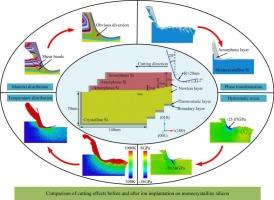通过分子动力学模拟研究带有非晶层的单晶硅材料的纳米切割机理
IF 6.1
1区 工程技术
Q1 ENGINEERING, MANUFACTURING
引用次数: 0
摘要
单晶硅在纳米切割过程中容易发生脆性断裂。通过离子注入对单晶硅进行表面改性,在其表面形成非晶层,可显著提高其加工性能。本文通过分子动力学模拟,深入揭示了带有非晶层的单晶硅的纳米切割机理。分析并深入讨论了非晶层对材料去除、次表面损伤、切削力、应力分布和温度曲线的影响。计算结果显示,在非晶层的影响下,主要材料去除模式从剪切过渡到挤压。非晶层的存在可以有效减少纳米加工过程中的应力集中和缺陷。当非晶层的厚度等于刀具的切削深度时,表面下的损伤会减少到大约 2 nm,这表明已经达到了最佳的表面质量。当非晶层厚度大于切削深度时,单晶硅部件的静水应力明显低于相变阈值 12 GPa,从而大大降低了相变的发生。此外,剪切带的形成和演变是导致切割力波动的主要原因。切削温度与结构转变密切相关。单晶硅材料剪切滑移产生的热量高于非晶层材料塑性变形产生的热量。此外,非晶层原子塑性变形产生的热能超过单晶硅原子结构转变产生的热能。这项研究揭示了基于相变的非晶层表面单晶硅材料的纳米切割行为。它可为非晶层表面单晶硅纳米切割过程中非晶层厚度的制备和切割参数的选择提供有效参考。本文章由计算机程序翻译,如有差异,请以英文原文为准。

Study on the nano-cutting mechanism of monocrystalline silicon material with an amorphous layer by molecular dynamics simulations
Monocrystalline silicon is prone to brittle fracture during the nano-cutting process. Surface modification through ion implantation to create an amorphous layer on monocrystalline silicon significantly enhances its processability. This paper conducted molecular dynamics simulations to deeply reveal the nanometric cutting mechanism for monocrystalline silicon with an amorphous layer. The influence of the amorphous layer on material removal, subsurface damage, cutting forces, stress distribution, and temperature profiles was analyzed and thoroughly discussed. The calculating results reveal that primary material removal mode transitions from shearing to extrusion under the influence of the amorphous layer. The presence of an amorphous layer can efficiently reduce stress concentration and defects in the nanometric machining process. When the thickness of the amorphous layer equals the cutting depth of the tool, subsurface damage is reduced to approximately 2 nm, indicating that an optimal surface quality is achieved. When the thickness of the amorphous layer reaches more than cutting depth, the hydrostatic stress of the monocrystalline silicon part is significantly lower than the phase transition threshold of 12 GPa, which greatly reduces the occurrence of phase transition. Furthermore, the formation and evolution of shear bands are the primary reasons for the fluctuations in cutting force. The cutting temperature is closely related to structural transformations. The heat generated by shear slip in monocrystalline silicon material is higher than the heat generated by plastic deformation of material in the amorphous layer. Moreover, the heat energy produced by plastic deformation of amorphous layer atoms exceeds that generated by structural transformation of monocrystalline silicon atoms. This work reveals the nanometric cutting behavior of the monocrystalline silicon material with amorphous layer surfaces based on phase transformation. It can provide effective references for the preparation of amorphous layer thickness and selection of cutting parameters in nanometric cutting process of the monocrystalline silicon with amorphous layer surfaces.
求助全文
通过发布文献求助,成功后即可免费获取论文全文。
去求助
来源期刊

Journal of Manufacturing Processes
ENGINEERING, MANUFACTURING-
CiteScore
10.20
自引率
11.30%
发文量
833
审稿时长
50 days
期刊介绍:
The aim of the Journal of Manufacturing Processes (JMP) is to exchange current and future directions of manufacturing processes research, development and implementation, and to publish archival scholarly literature with a view to advancing state-of-the-art manufacturing processes and encouraging innovation for developing new and efficient processes. The journal will also publish from other research communities for rapid communication of innovative new concepts. Special-topic issues on emerging technologies and invited papers will also be published.
 求助内容:
求助内容: 应助结果提醒方式:
应助结果提醒方式:


